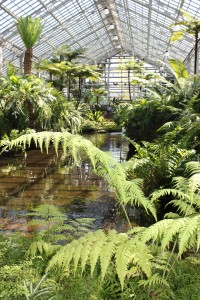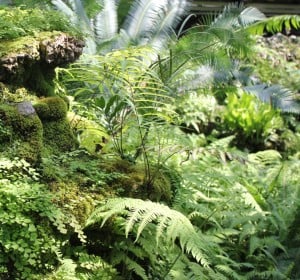
One of my favorite places, the great Garfield Park Conservatory in Chicago, is all shiny and sparkly. In a good way.
I remember when it was shiny and sparkly in a bad way: the day in June 2011 after golf-ball-sized hailstones smashed 60 percent of the glass in the nearly 2 acres of display greenhouses and the 10 propagation houses. On that awful day, there were shards of broken glass everywhere—cupped in the centers of bromeliads and 30-foot-tall cycads, stabbing the cacti in the Desert House, strewn on the soil in the Show House, nestled in the moss clinging to the limestone byways of the magnificent Fern Room. In the Fern Room and the Show House, 85 percent of the glass was lost.
Now, four years and $15 million later, all the panes in the display houses have been replaced with new, stronger laminated glass, and the conservatory has entirely reopened.
It was no easy task for the Chicago Park District to give the 107-year-old buildings a new glass roof. The entire steel structure had shifted when the weight of the old glass (last replaced in 1940) was suddenly removed, and it had to be reinforced to take the greater weight of the new double-paned glass.
But first, workers had to painstakingly hand-pick all those tiny shards of glass from plants and soil. In the Show House, the soil in all the beds was dug out a foot deep and replaced, to eliminate any danger to visitors and to the workers who dig in that soil to create new compositions of plants for seasonal displays. In the Fern Room, the moss that clings to limestone walls was vacuumed to remove the tiniest lurking danger.
The Fern Room is the centerpiece of the conservatory and one of my favorite places in Chicago. Landscape architect Jens Jensen designed the entire complex to break with the tradition of Victorian greenhouses, with their formal, symmetrical displays of potted plants, and instead create indoor landscapes that evoke the tropics, the desert, and the jungle where the plants live in the wild.
He designed the Fern Room, to give visitors a glimpse of their own landscape millions of years ago, when Illinois was a tropical swamp. Around a central lagoon, he had stonemasons stack up limestone slabs to create deep, mysterious canyons whose walls are carpeted in moss and delicate ferns. Giant cycads, relatives of plants known from 180-million-year-old fossils, reach toward the sky, as they would have in Chicago 300 million years ago.
The Fern Room was closed for nearly three years, while conservatory employees combed it for broken glass; the park district haggled with insurance companies; a fundraising campaign collected more than $800,000; scaffolding rose three stories to the roof, over those giant cycads; and the whole time, the surviving plants were carefully protected.
Because the hailstorm struck in June, it was not as devastating to temperature-sensitive plants as a cold snap in 1994 that burst heating pipes in the Aroid House, plunging the temperature to 25 degrees. That disaster helped galvanize public support for the aging conservatory, which stands in a troubled neighborhood on the city’s West Side, and led to the founding of the Garfield
Park Conservatory Alliance to support it.
Today, about 160,000 people visit each year to be transported into a different world, green and fantastic, soothing and spectacular. Even in the middle of a Chicago winter, this conservatory, like greenhouses everywhere, is a great escape.
The day the entire conservatory reopened this April, I was delighted to see the Show house full of families taking photos on their smartphones against an opulent background of spring flowers, with a jaunty flock of yellow umbrellas dangling from the refurbished ceiling overhead. The paths in the Aroid House were crowded. The acres of gardens outside the glass were in bloom. In the Fern Room, new moss had a ways to go to re-create the green carpet I remember by the central pool. But the limestone canyons that rose from Jensen’s imagination more than 100 years ago were as lush and mysterious as ever.


